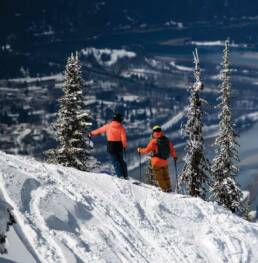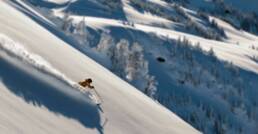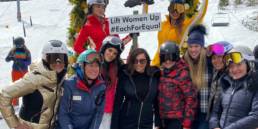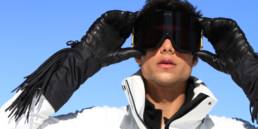At the end of the road but out of this world, this heli-ready chalet soars in Revelstoke, British Columbia.
You’d be forgiven for conjuring a cartoonish character when you hear the phrase “flying moose.” While it’s the perfect pop-cultural meme for a kid’s show super-hero, with the Flying Moose Chalet the phrase has an entirely different meaning—a semiotic for comfort, convenience, and the kind of intimate luxury it’s hard to engineer into large wood-beam structures.
Set at the base of Revelstoke Mountain Resort, the Moose is the final edifice on a street of large private group chalets, quietly outdoing them all: eight beautifully appointed guest suites with private bathroom that can accommodate up to 20; a lounge with projector screen; a fitness and massage room with steam shower; an outdoor sauna, large hot tub and infinity pool; a rock-climbing wall; an airy, bistro-style kitchen plus outdoor kitchen and dining area; a spacious ski room for storage and gearing up; the largest private helipad in the area; and, most importantly, a passionate team ready to assist with butler, housekeeping or chef services.
We arrive on a sunny February day, ready for three days of skiing. It isn’t the mountain or snow conditions that first get our attention, however, but the layout and detail of the interior as we’re led on a tour by chalet manager Erin. A timber structure of surpassing complexity, our necks crane as we walk, trying to comprehend the unique and exquisite beam work. The style—known as hammer beam truss—figured in large, open-timber roofs through the Gothic and Medieval eras. A legendary surviving example is London’s Westminster Hall, built in 1399. To create the feel of soaring, open space, hammer beams rely either on a building design that naturally buttresses the truss from both sides or, as here, light metal tie-rods that do the same work. As a result, the Douglas-fir timbers are joined with a combination of traditional mortice and tenon, oak pegs and blacksmith-forged steel connectors. The difficulty and cost of heating large spaces is obviated to some degree by the use of heat pumps and air conditioners. There are also several woodslab tables made from reclaimed timber, the massive version on the deck being particularly inspiring.
Tired from travelling and not wanting to leave our newfound cradle, we order in sushi from Kawakubo Japanese Restaurant in town. Being coast-dwellers from Whistler, our sushi standard resides at snob-level height, so we’re pleased to find Kawakubo nose up to that bar and beyond—the sushi as fresh as a dockside catch, with exceptional knife-work and art-class presentation.
In the morning—which arrives through generous windows in the main part of the chalet—we breakfast around the kitchen’s marble dining skirt then head out to ski. Were we so inclined, heli-skiing might be on the menu utilizing the chalet’s super-sized heli-pad—the only private landing in the valley large enough to accommodate a 14-person Bell 212. Guest groups can book directly with local operators CMH, Selkirk Tangiers Heli Skiing and Eagle Pass Heli Skiing, or have the chalet’s concierge arrange skiing on their behalf. Today, however, deep into an unusual snow drought, we head to the mountain and the certainty of plush corduroy. You can’t ski to the base from here but you can walk the easy 10 minutes; if you prefer to drive, the upper parking lot is but a minute away. Revelstoke Mountain Resort spreads skiers well over its 5,610-foot vertical, so we lap wide-open pistes unencumbered by crowds or line-ups, with views over the Columbia River Valley to the Monashee Mountains.
After skiing, we eschew on-mountain après in favor of a village stroll, tracking historic century buildings, post-war company houses, and an occasional art-deco surprise. On a word-of-mouth whim we duck into Monashee Spirits, a tiny, storefront distillery that balances in-house production of vodka, gin and liqueurs with a quality cocktail service at cozy wood tables. The drinks are superbly creative—from their names (“Strange Stolen Wishes,” “Cadillac Corpse,” “3:10 to Yuzu”) to execution with a range of local ingredients. The “Huck me Baby One More Time” sells me in a second with Huckleberry-infused gin, Aperol, cassis, lemon juice, and a triple dose of bitters. Not to mention it’s garnished with “an edible wafer print of a stick figure couple in a sexual position from the Kamasutra… You’ll want your camera for this one.” Indeed I did.
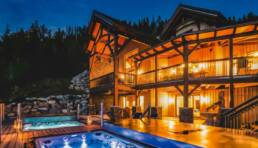
Returning to the chalet we have a chance to enjoy its comforts—massive double-sided fireplace that hosts a warm and spacious living room on one side and a cozy fireside chatspot on the other, screensavers on stealth televisions that look exactly like wall-hung photo art, and a worn Persian carpet and leather ottoman that seem perfectly in place amidst the manifold modernity. The unexpected brightest star in the décor galaxy is the light fixtures—each an attention-grabbing take on a current trend, adding up to an eclectic panoply of luminescence.
One of the benefits of the Moose is being able to do your own thing food-wise, have it fully catered, or strike a balance. We’ve opted for one private chef, wine-paired meal, choosing starters, main course and dessert from a small menu in advance. When we’d returned from skiing, Chef Jimmy was already deep into prep for the evening—which we now joyously find includes charcuterie and champagne in the upper lounge. Dinner itself begins on a butternut squash soup with truffle oil, accompanied by sourdough bread that’s so delicious I force myself to stop consuming it in order to accommodate the subsequent perfectly cooked beef tenderloin and pommes Anna with cauliflower purée, broccolini and Béarnaise sauce. Pulling in the reins also leaves room for the requisite wine-pairings— Erin pours delicious matches from the nearby Okanagan Valley—and a fabulous finale of chocolate torte.
The stars are out so an after-dinner jaunt is in order. And there, as we file out, set under an eave, is the chalet’s resident moose. He’s not flying unless you count the flight of fancy in his making by artist Zuzanna Riha—a sculptural bricolage of cleverly upcycled objects from shoes to computer keyboards to tennis rackets to mountain-bike parts to cellphones, all cobbled into a life-size rendition of every Canadian’s favorite cervid. It’s an ode to our relationship with stuff and to wildlife, and next to the opulence of the lodge it does cut a cartoonish, thoughtprovoking counterpoint: in the choice between quality and quantity, the former should always prevail.
Article by LESLIE ANTHONY
